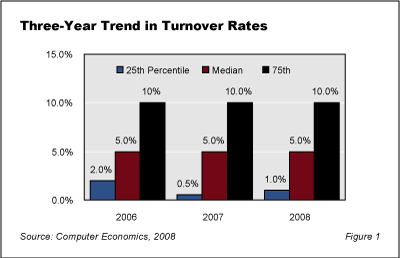Because it is generally less expensive to retain good employees than find new ones, lowering turnover rates is a good strategy for reducing personnel costs. This study finds that reducing turnover is a powerful cost-saving measure, because some of the most effective means of reducing turnover do not involve improving economic incentives such as salaries and bonuses. Non-financial incentives, such as enriching education and training opportunities or introducing quality-of-life factors such as flexible scheduling, can have a greater impact on retention than raising pay scales.
This Research Byte is a summary of our full report, Factors Influencing IT Employee Turnover Rates.
Despite the slowing economy, many IT executives today believe turnover is a growing problem. That may be because the problem is never just about retaining people, but about retaining the “right people.” In the changing IT landscape, certain skills will always be in short supply. The first question organizations need to answer is whether their turnover rates are outside the norm and need addressing.
Turnover Rate Benchmarks Relatively Stable
But what is the norm? Over the past three years, during a period of modest growth in the economy, the turnover rates of most IT staffs have been highly stable, as shown in Figure 1. Based on our annual survey of about 200 IT executives in the U.S. and Canada, turnover over the past three years has remained consistent at about 5% at the median and 10% at the 75th percentile. The top-performing organizations, those at the 25th percentile, have maintained turnover rates ranging from 0.5% to 2%.

The full version of this report examines current trends in turnover rates and provides benchmarks for turnover by organization size. We then examine 11 factors commonly believed to influence employee retention, specifically:
- Education and training opportunities
- Flexible schedules
- Work environment
- Social environment
- Incentive pay/bonuses, base salaries
- Insurance benefits
- Employee recognition programs
- Paid time off
- Retirement programs
- Telecommuting opportunities
We assess how IT executives rank the importance of these factors, and we measure the impact of each factor on actual turnover rates. We conclude with recommendations on how organizations can most cost-effectively reduce turnover.
Computer Economics Viewpoint
The turnover benchmarks provided in the full study are an important starting point for determining an organization’s potential return on investment in retention programs. The typical organization in today’s environment can view a 5% turnover as a normal cost of doing business. Organizations with higher turnover should be able to achieve good ROI through more careful attention to the problem. Moving a large organization to a best-of-class 2% level will be more difficult, and executives need to carefully weigh the costs and benefits of attempting to do so.
Executives also need to be aware that establishing programs to recruit qualified employees and establishing programs for retaining staff are not the same thing. Factors that make an organization attractive to potential employees are often the same ones that help a company retain staff. But some factors are more important for recruitment, while others are more important for retention. As the full study indicates, economic incentives may be more critical for attracting new hires, while quality-of-life factors may be more critical for retaining those employees.
The full version of this report quantifies the costs of employee turnover and illustrates the benefits of reducing turnover by investing additional funds in non-financial incentives. It also provides recommendations concerning which factors are likely to yield the greatest benefits to the organization.
This Research Byte is a brief overview of our report on this subject, Factors Influencing IT Employee Turnover Rates. The full report is available at no charge for Computer Economics clients, or it may be purchased by non-clients directly from our website at https://avasant.com/report/factors-influencing-it-employee-turnover-rates-2008/ (click for pricing).

